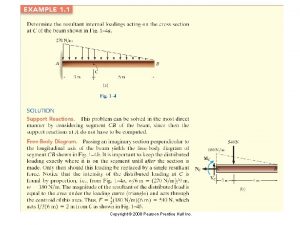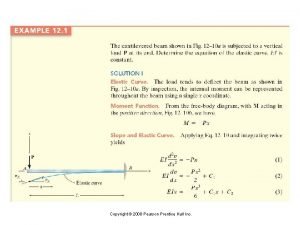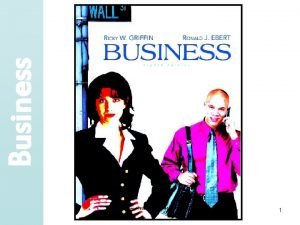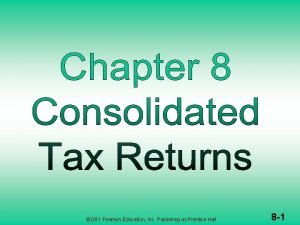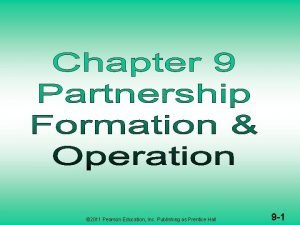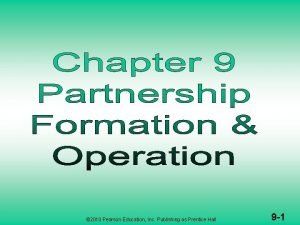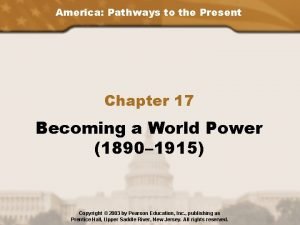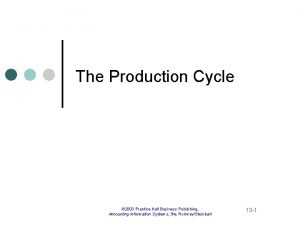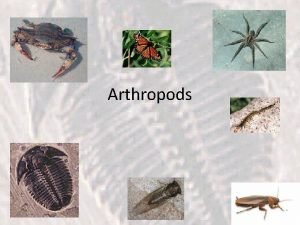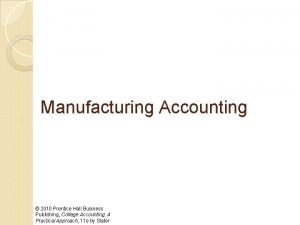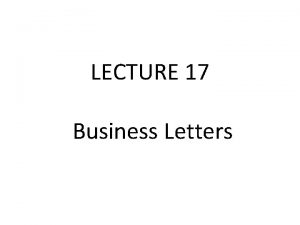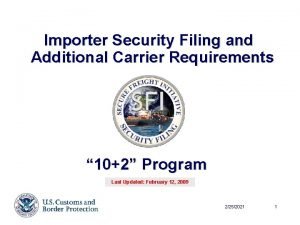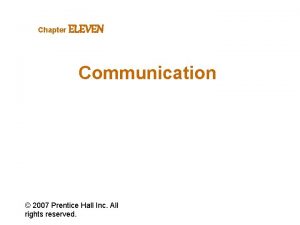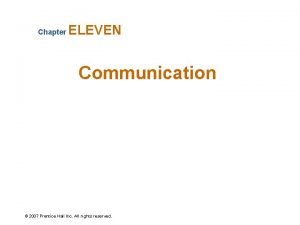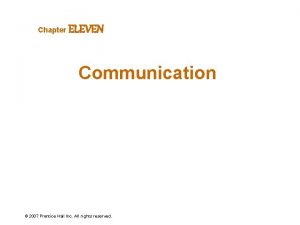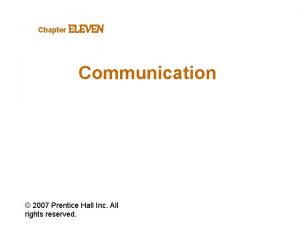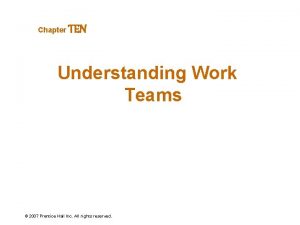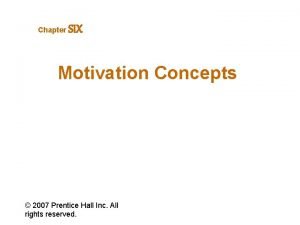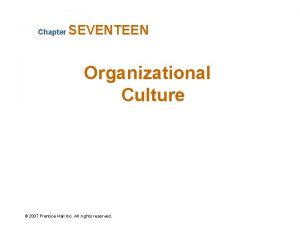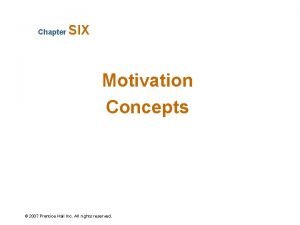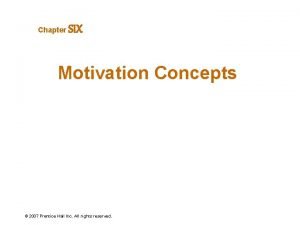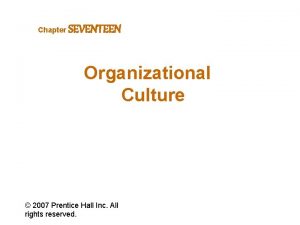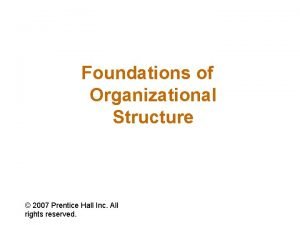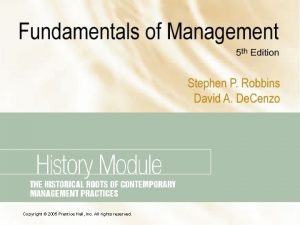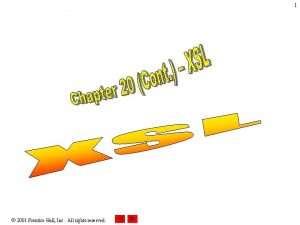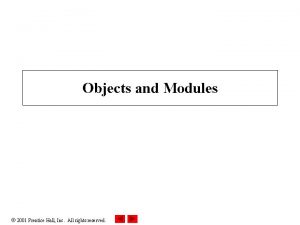Chapter TEN ams 2007 Prentice Hall Inc All

































- Slides: 33

Chapter TEN ams © 2007 Prentice Hall Inc. All rights reserved.

Learning Objectives Ø Explain the growing popularity of teams in organizations. Ø Contrast teams with groups. Ø Identify four types of teams. Ø Specify the characteristics of effective teams. Ø Explain how organizations can create team players. Ø Describe conditions when teams are preferred over individuals. © 2007 Prentice Hall Inc. All rights reserved.

Why Have Teams Become So Popular? Ø Teams typically outperform individuals. Ø Teams use employee talents better. Ø Teams are more flexible and responsive to changes in the environment. Ø Teams facilitate employee involvement. Ø Teams are an effective way to democratize an organization and increase motivation. © 2007 Prentice Hall Inc. All rights reserved.

Team Versus Group: What’s the Difference? Work Group A group that interacts primarily to share information and to make decisions to help each group member perform within his or her area of responsibility. q. Work groups have no need or opportunity to engage in collective work that requires joint effort. So their performance is merely the summation of each group member’s individual contribution. q. There is no positive synergy that would create an overall level of performance that is greater than the sum of the inputs. © 2007 Prentice Hall Inc. All rights reserved.

Team Versus Group: What’s the Difference? Work Team A group whose individual efforts result in a performance that is greater than the sum of the individual inputs. Ø A work team generates +ve synergy through coordinated effort. Ø Their individual efforts results in a level of performance that is greater than the sum of those individual inputs. Ø The use of teams creates the potential for an org. to generate Greater outputs with no increase In inputs. © 2007 Prentice Hall Inc. All rights reserved.

Comparing Work Groups and Work Teams © 2007 Prentice Hall Inc. All rights reserved. E X H I B I T 10– 1

Types of Teams Problem-Solving Teams Groups of 5 to 12 employees from the same department who meet for a few hours each week to discuss ways of improving quality, efficiency, and the work environment. In problem-solving teams, members share ideas or offer suggestions on how work processes & methods can be improved; although they rarely have the authority to unilaterally implement any of their suggested actions. © 2007 Prentice Hall Inc. All rights reserved.

Self-Managed Work Teams Groups of 10 to 15 people who take on the responsibilities of their former supervisors. S-M work teams are groups of employees who perform highly related or interdependent jobs & take on many of the responsibilities of their former supervisors. Typically, this includes planning & scheduling of work, assigning tasks to members, collective control over the pace of work, making operating decisions, taking action on problems, and working with suppliers & customers. Fully self-managed work teams even select their own members & have the members evaluate each other’s performance. As a result, supervisory positions take on decreased importance & may even be eliminated. © 2007 Prentice Hall Inc. All rights reserved.

Types of Teams (cont’d) Cross-Functional Teams Employees from about the same hierarchical level, but from different work areas, who come together to accomplish a task. • Task forces: is nothing other than a temporary cross -functional team. • Committees: composed of members from across dept. lines are another example of cross-functional teams. © 2007 Prentice Hall Inc. All rights reserved.

Types of Teams (cont’d) Virtual Teams that use computer technology to tie together physically dispersed members in order to achieve a common goal. Characteristics of Virtual Teams 1. The absence of paraverbal and nonverbal cues 2. A limited social context 3. The ability to overcome time and space constraints © 2007 Prentice Hall Inc. All rights reserved.

Para verbal Messages……. . 1 Ø Paraverbal communication refers to the messages that we transmit through the tone, pitch, and pacing of our voices. It is how we say something, not what we say. Professor Mehrabian states that the paraverbal message accounts for approximately 38% of what is communicated to someone. A sentence can convey entirely different meanings depending on the emphasis on words and the tone of voice. For example, the statement, "I didn't say you were stupid" has six different meanings, depending on which word is emphasized. © 2007 Prentice Hall Inc. All rights reserved.

Para verbal Messages……. . 2 Some points to remember about our “paraverbal” communication: q. When we are angry or excited, our speech tends to become more rapid and higher pitched. q. When we are bored or feeling down, our speech tends to slow and take on a monotone quality. q. When we are feeling defensive, our speech is often abrupt. Paraverbal Messages: 1. Account for about 38% of what is perceived and understood by others. 2. Include the tone, pitch, and pacing of our voice © 2007 Prentice Hall Inc. All rights reserved.

A Team. Effectiveness Model © 2007 Prentice Hall Inc. All rights reserved. E X H I B I T 10– 3

Creating Effective Teams © 2007 Prentice Hall Inc. All rights reserved.

Creating Effective Teams (cont’d) © 2007 Prentice Hall Inc. All rights reserved.

Key Roles of Teams © 2007 Prentice Hall Inc. All rights reserved. E X H I B I T 10– 4

Creating Effective Teams (cont’d) © 2007 Prentice Hall Inc. All rights reserved.

Creating Effective Teams (cont’d) Why are processes important to team effectiveness? ü 1+1+1 doesn’t necessarily add up to 3. üIn team tasks for which each member's contribution is not clearly visible, there is a tendency for individuals to decrease their effort. üSocial loafing – a process loss as a result of using teams. Teams should create outputs greater than the sum of their inputs © 2007 Prentice Hall Inc. All rights reserved.

Effects of Group Processes = + MINUS Goal: Maximize Process Gains While Minimizing Process Losses! © E X H I B I T 10– 5 2007 Prentice Hall Inc. All rights reserved.

Team Processes Ø Common Plan & Purpose: an effective team has a common plan & purpose that provides direction, momentum, & commitment for members. This purpose is a vision, or master plan. It is broader than specific goals. Ø Team Efficacy: Effective teams have confidence in themselves. They believe they can succeed. This is called “team efficacy”. Success breeds success. Teams that have been successful raise their belief about future success, which in turn, motivates them to work hard. © 2007 Prentice Hall Inc. All rights reserved.

Creating Effective Teams: Diversity Group Demography The degree to which members of a group share a common demographic attribute, such as age, sex, race, educational level, or length of service in the organization. Cohorts Individuals who, as part of a group, hold a common attribute. © 2007 Prentice Hall Inc. All rights reserved.

Turning Individuals Into Team Players… 1 Ø To this point, we’ve made a strong case for the value & growing popularity of teams. Ø But many people are not inherently team players. Ø They are loners or people who want to be recognized for their individual achievements. Ø There also many orgs. that have historically fostered individual accomplishments. They have created competitive work environments in which only the strong survive. Ø If these orgs. adopt teams, what do they do about the selfish, “ I’ve-got-to-look-out-for-me” employees that they’ve created? © 2007 Prentice Hall Inc. All rights reserved.

Turning Individuals Into Team Players… 2 Ø Also, countries differ in terms of how they rate on individualism & collectivism. Ø Teams fit well with countries that score high on collectivism. Ø But what if an org. wants to introduce teams into a work population that is made up largely of individuals born & raised in an individualistic society? © 2007 Prentice Hall Inc. All rights reserved.

Turning Individuals Into Team Players…. . 1 The Challenges – Overcoming individual resistance to team membership. – Countering the influence of individualistic cultures. – Introducing teams in an organization that has historically valued individual achievement. Ø The previous points were meant to dramatize that one big barrier to using work teams is individual resistance. Ø An employee’s success is no longer defined in terms of individual performance. Ø To perform well as team members, individuals must be able to communicate openly & honestly, to confront differences & resolve conflicts, & to sublimate personal goals for the good of the team. Ø For many employees, this is a difficult- sometimes impossible-task. © 2007 Prentice Hall Inc. All rights reserved.

Turning Individuals Into Team Players…. . 1 The Challenges Ø 1) 2) Ø Ø The challenge of creating team players will be greatest when The national culture is highly individualistic and The teams are being introduced into an established org. that has historically valued individual achievement. This describes, for instance, what faced managers at AT&T, Ford, Motorola, & other large US-based companies. These orgs. prospered by hiring & rewarding corporate stars, and they bred a competitive climate that encouraged individual achievement & recognition. Employees in these types of firms can be jolted by this sudden shift to the importance of team play. A veteran employee of a large company, who had done well working alone, described the experience of joining a team: “ I am learning my lesson. I just had my first –ve performance appraisal in 20 years. ” © 2007 Prentice Hall Inc. All rights reserved.

Turning Individuals Into Team Players…. . 2 Ø Shaping Team Players – Selecting employees who can fulfill their team roles. – Training employees to become team players. – Reworking the reward system to encourage cooperative efforts while continuing to recognize individual contributions. Ø Selection: ü some people already possess the interpersonal skills to be effective team player. ü When hiring team members, in addition to the technical skills required to fill the job, care should be taken to ensure that candidates can fulfill their team roles as well as the technical requirements. ü Candidate can go under training / transferred to another unit within the org. without teams /don’t hire the candidate. © 2007 Prentice Hall Inc. All rights reserved.

Shaping Team Players Ø Training ü People raised on individual accomplishments can be trained to become team players. ü Training specialist conduct exercises that allow employees to experience the satisfaction that teamwork can provide. ü They help employees to improve their problem-solving, communication, negotiation, conflict-management, & coaching skills. Ø Rewards ü The reward system needs to be reworked to encourage cooperative efforts rather competitive ones. ü Promotions, pay raises & other forms of recognition should be given to individuals for how effective they are as a collaborative team member. ü This doesn’t mean individual contributions are ignored; rather, they are balanced with selfless contributions to the team. © 2007 Prentice Hall Inc. All rights reserved.

Teams and Quality Management Ø “Improving Quality” has garnered increased attention towards team play in quality management (QM) programs. Ø The essence of QM is process improvement, & employee involvement is the linchpin ( number one) of process improvement. Ø QM requires management to give employees the encouragement to share ideas & act on what they suggest. Ø All such techniques & processes require high levels of communication & contact, response & adaptation, & coordination. Ø Ford began its QM efforts as the primary organizing mechanism. Ø “ because this business is so complex, you can’t make an impact on it without a team approach, ” noted one Ford manager. © 2007 Prentice Hall Inc. All rights reserved.

Ø Ford’s management identified five goals in designing its quality problem-solving teams. Ø The teams should: 1. be small enough to be efficient and effective. 2. be properly trained in skills their members will need. 3. be allocated enough time to work on problems they plan to address. 4. be given the authority to resolve problems and take corrective action. 5. have a designated “champion” whose job is to help the team get around roadblocks that arise. © 2007 Prentice Hall Inc. All rights reserved.

Beware: Teams Aren’t Always the Answer Ø Teamwork takes more time & often more resources than individual work. Ø So the benefits of using teams have to exceed the costs. Ø How do you know if the work of your group would be better done in teams? Ø Three tests to see if a team fits the situation: – Is the work complex and is there a need for different perspectives? – Does the work create a common purpose or set of goals for the group that is larger than the aggregate of the goals for individuals? – Are members of the group involved in interdependent tasks? © 2007 Prentice Hall Inc. All rights reserved.

Chapter Check-Up: Teams What kinds of things have you experienced in a team setting that could be considered as process loss? Choose two and write them down. Possibilities include: Too much socializing, coordinating work flow, lag time in responses to emails, personality conflicts, attendance and timeliness problems, etc. © 2007 Prentice Hall Inc. All rights reserved.

Chapter Check-Up: Teams If you were asked to choose people from your class right now to make up a team for a class project, list five individuals you would choose. Now that you have your list, consider what the composition of your team would look like. How much diversity would there be? Given what we learned in this chapter, what would the pros and cons of your composition be? © 2007 Prentice Hall Inc. All rights reserved.

Chapter Check-Up: Teams Is conflict in a team good or bad? Discuss. Conflict can be both good and bad. Task conflict is beneficial for a team because it helps protect against groupthink. Relationship conflict is bad for a team’s morale. What, specifically, can you do to create task conflict in a group? Think about the reality of trying to “stir the pot”… and write down a phrase you could say (e. g. , you would feel comfortable saying to your peers) to create task conflict. © 2007 Prentice Hall Inc. All rights reserved.
 Copyright 2008
Copyright 2008 Pearson prentice hall
Pearson prentice hall 2008 pearson prentice hall inc
2008 pearson prentice hall inc Copyright 2005 pearson prentice hall inc
Copyright 2005 pearson prentice hall inc Prentice hall inc
Prentice hall inc Pearson education inc publishing as pearson prentice hall
Pearson education inc publishing as pearson prentice hall 2011 pearson education inc
2011 pearson education inc 2005 pearson prentice hall inc
2005 pearson prentice hall inc Pearson education inc publishing as pearson prentice hall
Pearson education inc publishing as pearson prentice hall Pearson education inc. publishing as prentice hall
Pearson education inc. publishing as prentice hall Pearson education inc. 2012
Pearson education inc. 2012 2012 pearson education inc
2012 pearson education inc 2011 pearson education inc
2011 pearson education inc 2011 pearson education inc
2011 pearson education inc Pearson education 2010
Pearson education 2010 Pearson education inc. publishing as prentice hall
Pearson education inc. publishing as prentice hall Pearson prentice hall
Pearson prentice hall Prentice hall careers
Prentice hall careers Prentice hall america pathways to the present
Prentice hall america pathways to the present Prentice hall publishing
Prentice hall publishing Prentice hall african american history
Prentice hall african american history Prentice hall physical science: concepts in action
Prentice hall physical science: concepts in action Pearson prentice hall
Pearson prentice hall Pearson prentice hall
Pearson prentice hall Arthropods common name
Arthropods common name Prentice hall business publishing
Prentice hall business publishing Prentice hall jobs
Prentice hall jobs Ten twenty thirty forty
Ten twenty thirty forty Ten ten siempre fuerzas y esperanza
Ten ten siempre fuerzas y esperanza Am i a 10/10
Am i a 10/10 Name all rays
Name all rays Ams 4:23
Ams 4:23 Business letters introduction
Business letters introduction Ams filing requirements
Ams filing requirements

